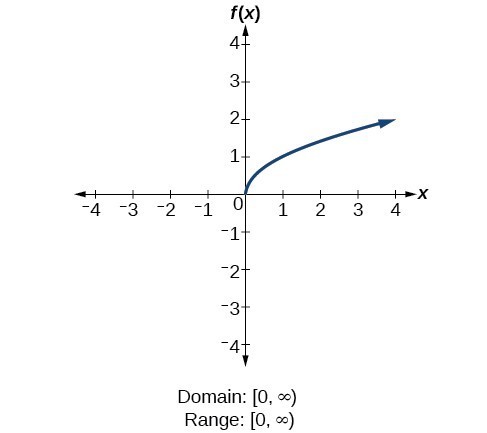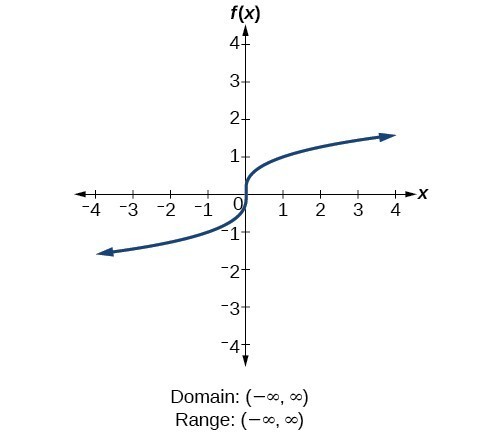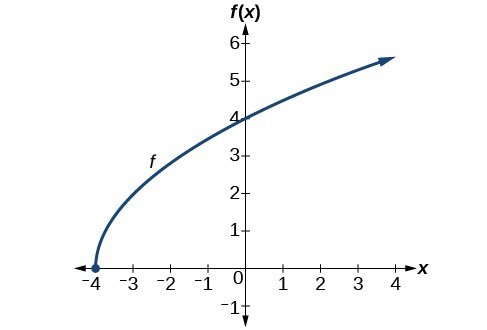Learning Objectives
- (9.3.1) – Evaluating Radical functions
- (9.3.2) – Finding the domain of a radical function
In this section we will extend our previous work with functions to include radicals. If a function is defined by a radical expression, we call it a radical function.
The square root function is [latex]f(x) = \sqrt{x}[/latex].
The cube root function is [latex]f(x) = \sqrt[3]{x}[/latex].
The following are examples of rational functions: [latex]f(x)=\sqrt{2x^4-5}[/latex]; [latex]g(x)=\sqrt[3]{4x-7}[/latex]; [latex]h(x)=\sqrt[7]{-8x^2+4}[/latex].
(9.3.1) – Evaluating a radical function
To evaluate a radical function, we find the value of [latex]f(x)[/latex] for a given value of [latex]x[/latex] just as we did in our previous work with functions.
EXAMPLE
For the function [latex]f(x) = \sqrt{2x-1}[/latex], find [latex]f(5)[/latex]
EXAMPLE
For the function [latex]f(x) = \sqrt{-4x+5}[/latex], find [latex]f(-5)[/latex]
Try It
In the following example we evaluate a cube root function.
ExAMPLE
For the function [latex]f(x) = \sqrt[3]{x-29}[/latex], find [latex]f(2)[/latex]
(9.3.2) – Finding the domain of a radical function
For the square root function [latex]f\left(x\right)=\sqrt[]{x}[/latex], we cannot take the square root of a negative real number, so the domain must be 0 or greater. The range also excludes negative numbers because the square root of a positive number [latex]x[/latex] is defined to be positive, even though the square of the negative number [latex]-\sqrt{x}[/latex] also gives us [latex]x[/latex]. The following is a graph of the square root function:

For the cube root function [latex]f\left(x\right)=\sqrt[3]{x}[/latex], the domain and range include all real numbers. Note that there is no problem taking a cube root, or any odd-integer root, of a negative number, and the resulting output is negative (it is an odd function). Here is the graph of the cube root function:

We use this to find the domains of other radical functions.
How To: Given a function written in equation form including an even root, find the domain.
- Identify the input values.
- Since there is an even root, exclude any real numbers that result in a negative number in the radicand. Set the radicand greater than or equal to zero and solve for [latex]x[/latex].
- The solution(s) are the domain of the function. If possible, write the answer in interval form.
Example: Finding the Domain of a Function with an Even Root
Find the domain of the function [latex]f\left(x\right)=\sqrt{7-x}[/latex].
EXAMPLE
Find the domain of the function [latex]f\left(x\right)=\sqrt{5+2x}[/latex].
Try It
Example: Finding the Domain and Range
Find the domain and range of [latex]f\left(x\right)=2\sqrt{x+4}[/latex].
Candela Citations
- Question ID#73906. Authored by: Meacham,William. License: Public Domain: No Known Copyright
- Revision and Adaptation. Provided by: Lumen Learning. License: CC BY: Attribution
- Intermediate Algebra. Authored by: Lynn Marecek et al.. Provided by: OpenStax. Located at: http://cnx.org/contents/02776133-d49d-49cb-bfaa-67c7f61b25a1@3.16. License: CC BY: Attribution. License Terms: Download for free at http://cnx.org/contents/02776133-d49d-49cb-bfaa-67c7f61b25a1@3.16
- Question ID 30831, 32883. Authored by: Smart, Jim. License: CC BY: Attribution
- College Algebra. Provided by: Open Stax. Located at: http://cnx.org/contents/9b08c294-057f-4201-9f48-5d6ad992740d@3.278:1/Preface. License: Public Domain: No Known Copyright. License Terms: Download for free at : http://cnx.org/contents/9b08c294-057f-4201-9f48-5d6ad992740d@3.278:1/Preface
